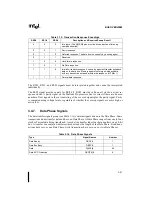
3-6
BUS OVERVIEW
•
Deferred
•
Retry
If the transaction does not have a Data Phase, that transaction is complete after the Response
Phase. If the request agent has write data to transfer or is requesting read data, the transaction
has a Data Phase which may extend beyond the Response Phase.
Not all transactions contain all phases, not all phases occur in order, and some phases can be
overlapped.
•
All transactions that are not cancelled in the Error Phase have the Request, Error, Snoop,
and Response Phases.
•
Arbitration can be explicit or implicit. The Arbitration Phase only needs to occur if the
agent that is driving the next transaction does not already own the bus.
•
The Data Phase only occurs if a transaction requires a data transfer. The Data Phase can be
absent, response initiated, request initiated, snoop initiated, or request and snoop initiated.
•
The Response Phase overlaps with the beginning of the Data Phase for read transactions.
•
The Response Phase (TRDY#) triggers the Data Phase for write transactions.
In addition, since the Pentium Pro processor bus supports bus transaction pipelining, phases
from one transaction can overlap phases from another transaction, see Figure 3-2.
3.3.2.
Bus Transaction Pipelining and Transaction Tracking
The Pentium Pro processor bus architecture supports pipelined transactions in which bus trans-
actions in different phases overlap. The Pentium Pro processor bus may be configured to support
a maximum of 1 or 8 outstanding transactions simultaneously. Each Pentium Pro processor is
capable of issuing up to four outstanding transactions.
In order to track transactions, all bus agents must track certain transaction information. The
transaction information that must be tracked by each bus agent is:
•
Number of transactions outstanding
•
What transaction is next to be snooped
•
What transaction is next to receive a response
•
If the transaction was issued to or from this agent
This information is tracked in a queue called an In-order Queue (IOQ). All bus agents maintain
identical In-order Queue status to track every transaction that is issued to the bus. When a trans-
action is issued to the bus, it is also entered in the IOQ of each agent. The depth of the smallest
IOQ is the limit of how many transactions can be outstanding on the bus simultaneously. Be-
cause transactions receive their responses and data in the same order as they were issued, the
transaction at the top of the IOQ is the next transaction to enter the Response and Data Phases.
A transaction is removed from the IOQ after the Response Phase is complete or after an error is
detected in the Error Phase. The simplest bus agents can simply count events rather than imple-
ment a queue.
Summary of Contents for Pentium Pro Family
Page 17: ...1 Component Introduction ...
Page 26: ...2 Pentium Pro Processor Architecture Overview ...
Page 27: ......
Page 36: ...3 Bus Overview ...
Page 62: ...4 Bus Protocol ...
Page 105: ...5 Bus Transactions and Operations ...
Page 126: ...6 Range Registers ...
Page 131: ...7 Cache Protocol ...
Page 135: ...8 Data Integrity ...
Page 148: ...9 Configuration ...
Page 161: ...10 Pentium Pro Processor Test Access Port TAP ...
Page 172: ...11 Electrical Specifications ...
Page 201: ...12 GTL Interface Specification ...
Page 229: ...13 3 3V Tolerant Signal Quality Specifications ...
Page 233: ...14 Thermal Specifications ...
Page 239: ...15 Mechanical Specifications ...
Page 241: ...15 2 MECHANICAL SPECIFICATIONS s Figure 15 1 Package Dimensions Bottom View ...
Page 252: ...16 Tools ...
Page 260: ...16 8 TOOLS Figure 16 4 Generic MP System Layout for Debug Port Connection ...
Page 264: ...17 OverDrive Processor Socket Specification ...
Page 290: ...A Signals Reference ...
Page 320: ...Index ...
Page 328: ......
















































